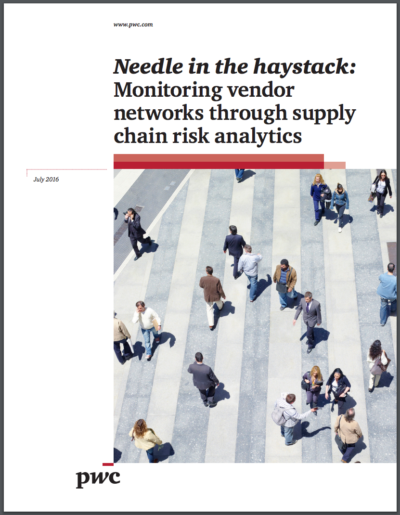Though rebounding job numbers are no doubt a positive development for the nation and economy, they actually pose a mixed blessing for corporations and business enterprises.
Why? When employees succeed in finding a new job someplace else, their job performance and commitment often lag after they’ve given notice. In a sense, it’s human nature to take your foot off the gas and your eyes off the road when you’ve a new destination in mind. Furthermore, it’s likely that the professional leaving no longer considers the brand and reputation of the organization his/her priority. And, like a distracted or disinterested driver, that lack of attention and care may result in some serious damage — to their duties and to the reputation and brand of their employer.
That’s why I believe focusing on “conduct risk,” or “culture risk,” should be placed near the top of a business’ priority list. In my experience leading a division focused on corporate risk-sensing and reputation management, I’ve observed a “90/10” rule: that 90 percent of the hazardous workplace and professional behaviors arise or are magnified when an employee has set their sights on a new job and their focus dips.
I believe this is a hazard because your employees perform two critical services: they have a positive impact on your client base by doing quality work to the best of their abilities, and they serve as stewards of your enterprise’s reputation. If their performance declines because of lagging focus, your customers or clients will take notice and they will be acutely aware of low-quality service. Worse off, they may impact the organization’s reputation through one careless move with proprietary information, a click of a mouse on a social media site or an email to the wrong party. Many become disconnected from the organization’s purpose the day they give notice.
Businesses and leaders may want to address this in a two-pronged way: proactive awareness and the use of tools and technologies to continuously monitor employee conduct and culture throughout an employee’s life cycle.
A number of methods can be put into place to boost awareness in the workplace so that business leaders can stop a threat in its tracks. By having an environment where staff productively and positively perpetuates quality work from the top levels down, you can lower the odds that a decline in job commitment or behavior is permitted. When an employee gives notice, there are ways to surround that employee with the proper guidance to reiterate their obligations to the organization until the day they leave.
There are also technological tools through cutting-edge information technology that can detect odd shifts in behavior that can be examined for potentially out-of-line activity. Cognitive technology and surveying your employees may play a role in this cultural risk sensing process. These tools can be used to understand and react to employee behavior until the day one leaves the organization.
As much as businesses are focused on their outward branding investments, it’s worth the time, energy and resources to inculcate the workplace with an internal brand and reputation. When you can identify and define the behavioral goals of your personnel and create a consistent tone and monitoring mechanisms, you can reinforce expectations and provide day-to-day support in maintaining it.
The issues surrounding “culture risk” are on the rise: the new demographic of millennials entering the workforce with a unique world view, contingent workforces, mergers and the internal attempts to strike the right blend of tone and the refreshing attention to work-life balance that carries with it a new set of challenges. All of these and more can be incorporated into a successful and effective business, but they require leaders with the vision and attention to put practices in play.
I remember early in my professional career hearing friends and colleagues say, first impressions are vital in setting a tone, but everyone remembers how you leave and that lasting legacy. Businesses owe it themselves to take actions today and every day to help ensure that their personnel set a consistent performance standard and live up to it until their last day at the office — to project a legacy of reputational excellence for themselves and their business.



 Chuck Saia is CEO, Deloitte Risk and Financial Advisory. Chuck leads a risk consulting and financial advisory business comprised of 12,500+ professionals. Deloitte Risk and Financial Advisory helps organizations turn critical and complex business issues into opportunities for growth, resilience, and long-term advantage. Chuck has more than 24 years of experience advising clients on corporate governance, regulatory issues, risk management, and internal controls.
Chuck serves on the Executive Committee of Deloitte and reports directly to Cathy Engelbert, CEO of Deloitte. He has an unwavering commitment to the success of our firm, our professionals, and our clients.
Prior to his current role, Chuck served as the chief risk, reputation and regulatory affairs officer for Deloitte. In this role, he led the transformation of Deloitte’s approach to risk management, changing the conversation around reputation in the marketplace, and serving as a valued advisor to clients, nonprofits, and global organizations. Chuck oversaw strategic and reputational risk management; regulatory affairs; ethics and compliance; confidentiality and privacy matters; independence and business conflict; reputational sensing; and crisis management. He has been instrumental in advancing Deloitte’s brand through frequent client C-suite interactions and marketplace eminence.
Chuck developed and drove the enterprise-wide effort to protect, preserve, and enhance Deloitte’s reputation to clearly distinguish the organization as the leader in professional services in the marketplace. He developed and executed on a comprehensive strategy that aligned Strategic Risk, Reputation and Regulatory Affairs (SRRRA) with other organizational interdependencies. By engaging with leaders and professionals at all levels of the enterprise, he drove cultural change across the organization and set the tone on reputation, ensuring that Deloitte’s people understand the critical role they play in safeguarding Deloitte’s reputation.
Under his leadership, SRRRA transformed Deloitte’s focus on risk from a traditional enterprise risk management (ERM) approach to one that’s more strategic and nimble, repositioning risk as a key enabler to the different businesses so they can adjust and mitigate top and emerging risks, accordingly. Chuck led SRRRA in creating world-class strategic risk management capabilities, including reputational sensing (reputational, regulatory, vendor, etc.), competitor disruption, portfolio fit, culture risk, insider threat monitoring, third-party risk management, and a comprehensive regulatory strategy and stakeholder wiring map.
Previously, Chuck led the governance of Deloitte’s most strategic risks and related opportunities as Deloitte’s chief risk, reputation and crisis officer. He was responsible for overseeing the US organization-wide reputation and risk governance practices. He oversaw the strategic risk management program and led the efficient and effective governance of Deloitte’s most strategic risks and related opportunities. Chuck also oversaw all functional risk leaders while reporting directly to the CEO.
In previous roles, Chuck oversaw the Advisory Business Risk Service Area practice (formerly known as AERS Advisory), leading various market offerings, service lines, and regions. In addition, he served as the lead client service partner and lead risk partner for several high-profile clients.
Chuck has developed relationships at the C-suite level with Deloitte’s key clients and meets with them regularly to discuss current trends in strategic risk, reputation, and regulatory issues while advising client teams dealing with various complex client engagements. He has represented Deloitte as the keynote speaker at high profile events such as the Extended Enterprise Risk Management Executive Summit and the Million Women Mentors Summit and Awards Gala on the Hill.
Chuck contributes frequently to thought leadership, reporters’ requests and publishing bylines on strategic and reputational risk, crisis response, compliance issues, and other subjects related to reputation and corporate governance. His recently published titles in industry-leading outlets include: “Managing Risk with Digital Technology” and “Turning Reputational Risk into Opportunity,” in the WSJ Risk & Compliance Journal; “To be the disrupted or the disruptor? That is the question,” in CEO Magazine; a three-part series on reputational risk in Directors & Boards; “Triple threat: How to handle three top risks to reputation” and “Practical Ideas on Managing Reputation Risk” in Compliance Week; and “Here’s the best advice I can give you about protecting your reputation” in Business Insider.
Chuck utilizes social media (Twitter, LinkedIn) to build Deloitte eminence and spark conversations around leadership, diversity, and strategic and reputational risk. His insights are regularly featured on various industry groups handles.
Chuck has held various leadership positions at Deloitte, including National Leader of Business Risk Service Area; Northeast Leader of Enterprise Risk Services; National Leader Risk Advisory—Financial Services. Chuck has also served as Lead Client Service Partner and Lead Advisory Partner for multiple multinational banking and financial services clients.
He is a Certified Public Accountant and has an MBA from Quinnipiac University with a focus on internal controls. He serves on various boards, including the Lupus Foundation of New Jersey, the Quinnipiac University’s Business School NYC Advisory Committee, and the Mustang Travel Sports Club of NJ.
A father of two boys and resident of New Jersey, Chuck is committed to giving back to his community through volunteering and pro bono efforts. Chuck is an avid runner, a passionate fisherman, and a devoted fan of the New York Yankees, New York Giants, and New York Knicks.
Chuck Saia is CEO, Deloitte Risk and Financial Advisory. Chuck leads a risk consulting and financial advisory business comprised of 12,500+ professionals. Deloitte Risk and Financial Advisory helps organizations turn critical and complex business issues into opportunities for growth, resilience, and long-term advantage. Chuck has more than 24 years of experience advising clients on corporate governance, regulatory issues, risk management, and internal controls.
Chuck serves on the Executive Committee of Deloitte and reports directly to Cathy Engelbert, CEO of Deloitte. He has an unwavering commitment to the success of our firm, our professionals, and our clients.
Prior to his current role, Chuck served as the chief risk, reputation and regulatory affairs officer for Deloitte. In this role, he led the transformation of Deloitte’s approach to risk management, changing the conversation around reputation in the marketplace, and serving as a valued advisor to clients, nonprofits, and global organizations. Chuck oversaw strategic and reputational risk management; regulatory affairs; ethics and compliance; confidentiality and privacy matters; independence and business conflict; reputational sensing; and crisis management. He has been instrumental in advancing Deloitte’s brand through frequent client C-suite interactions and marketplace eminence.
Chuck developed and drove the enterprise-wide effort to protect, preserve, and enhance Deloitte’s reputation to clearly distinguish the organization as the leader in professional services in the marketplace. He developed and executed on a comprehensive strategy that aligned Strategic Risk, Reputation and Regulatory Affairs (SRRRA) with other organizational interdependencies. By engaging with leaders and professionals at all levels of the enterprise, he drove cultural change across the organization and set the tone on reputation, ensuring that Deloitte’s people understand the critical role they play in safeguarding Deloitte’s reputation.
Under his leadership, SRRRA transformed Deloitte’s focus on risk from a traditional enterprise risk management (ERM) approach to one that’s more strategic and nimble, repositioning risk as a key enabler to the different businesses so they can adjust and mitigate top and emerging risks, accordingly. Chuck led SRRRA in creating world-class strategic risk management capabilities, including reputational sensing (reputational, regulatory, vendor, etc.), competitor disruption, portfolio fit, culture risk, insider threat monitoring, third-party risk management, and a comprehensive regulatory strategy and stakeholder wiring map.
Previously, Chuck led the governance of Deloitte’s most strategic risks and related opportunities as Deloitte’s chief risk, reputation and crisis officer. He was responsible for overseeing the US organization-wide reputation and risk governance practices. He oversaw the strategic risk management program and led the efficient and effective governance of Deloitte’s most strategic risks and related opportunities. Chuck also oversaw all functional risk leaders while reporting directly to the CEO.
In previous roles, Chuck oversaw the Advisory Business Risk Service Area practice (formerly known as AERS Advisory), leading various market offerings, service lines, and regions. In addition, he served as the lead client service partner and lead risk partner for several high-profile clients.
Chuck has developed relationships at the C-suite level with Deloitte’s key clients and meets with them regularly to discuss current trends in strategic risk, reputation, and regulatory issues while advising client teams dealing with various complex client engagements. He has represented Deloitte as the keynote speaker at high profile events such as the Extended Enterprise Risk Management Executive Summit and the Million Women Mentors Summit and Awards Gala on the Hill.
Chuck contributes frequently to thought leadership, reporters’ requests and publishing bylines on strategic and reputational risk, crisis response, compliance issues, and other subjects related to reputation and corporate governance. His recently published titles in industry-leading outlets include: “Managing Risk with Digital Technology” and “Turning Reputational Risk into Opportunity,” in the WSJ Risk & Compliance Journal; “To be the disrupted or the disruptor? That is the question,” in CEO Magazine; a three-part series on reputational risk in Directors & Boards; “Triple threat: How to handle three top risks to reputation” and “Practical Ideas on Managing Reputation Risk” in Compliance Week; and “Here’s the best advice I can give you about protecting your reputation” in Business Insider.
Chuck utilizes social media (Twitter, LinkedIn) to build Deloitte eminence and spark conversations around leadership, diversity, and strategic and reputational risk. His insights are regularly featured on various industry groups handles.
Chuck has held various leadership positions at Deloitte, including National Leader of Business Risk Service Area; Northeast Leader of Enterprise Risk Services; National Leader Risk Advisory—Financial Services. Chuck has also served as Lead Client Service Partner and Lead Advisory Partner for multiple multinational banking and financial services clients.
He is a Certified Public Accountant and has an MBA from Quinnipiac University with a focus on internal controls. He serves on various boards, including the Lupus Foundation of New Jersey, the Quinnipiac University’s Business School NYC Advisory Committee, and the Mustang Travel Sports Club of NJ.
A father of two boys and resident of New Jersey, Chuck is committed to giving back to his community through volunteering and pro bono efforts. Chuck is an avid runner, a passionate fisherman, and a devoted fan of the New York Yankees, New York Giants, and New York Knicks.







